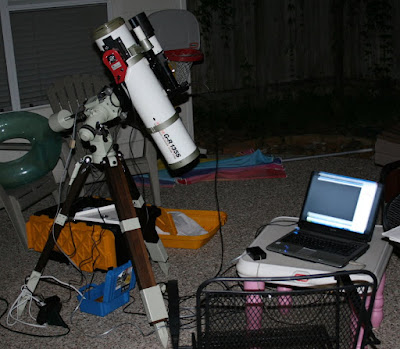Ever since the mount arrived a few weeks ago, we have had soupy weather. Every night has been cloudy, and if the clouds cleared off for a few hours at night the skies were hazy with water vapor. I took the mount out twice last week hoping to get the mount to autoguide, but just as I really came close to figuring out what was going on, the sky clouded over! So, finally, last night the sky cleared--not well, it's still pretty hazy, but clear enough to set up the mount, start Stark Labs' PHD autoguiding software, and figure out how to autoguide this mount. Success!
Autoguiding is basically the use of a second camera to create a feedback loop with the mount and a computer. The mount is already tracking the stars by motor pretty well. The guiding camera takes an image of the stars, sends it to a computer, and the computer sends commands to the mount. If the mount does not track the star exactly, the computer sends a correcting command to the mount to get it back on course. The guide camera tonight, a DSI Pro, was taking consecutive 3.5 second images through a 60mm f/5 achromat refractor mounted sturdily on the back of my Vixen R135S. The image from the guide camera was monitored by PHD, which sent correcting commands to the EM-10. I've had glitches before tonight (all of them generated by my own ignorance or carelessness), but finally everything came together.
Hooray! Let the fun begin! First target: M3 (which was approaching the zenith).

No comments:
Post a Comment